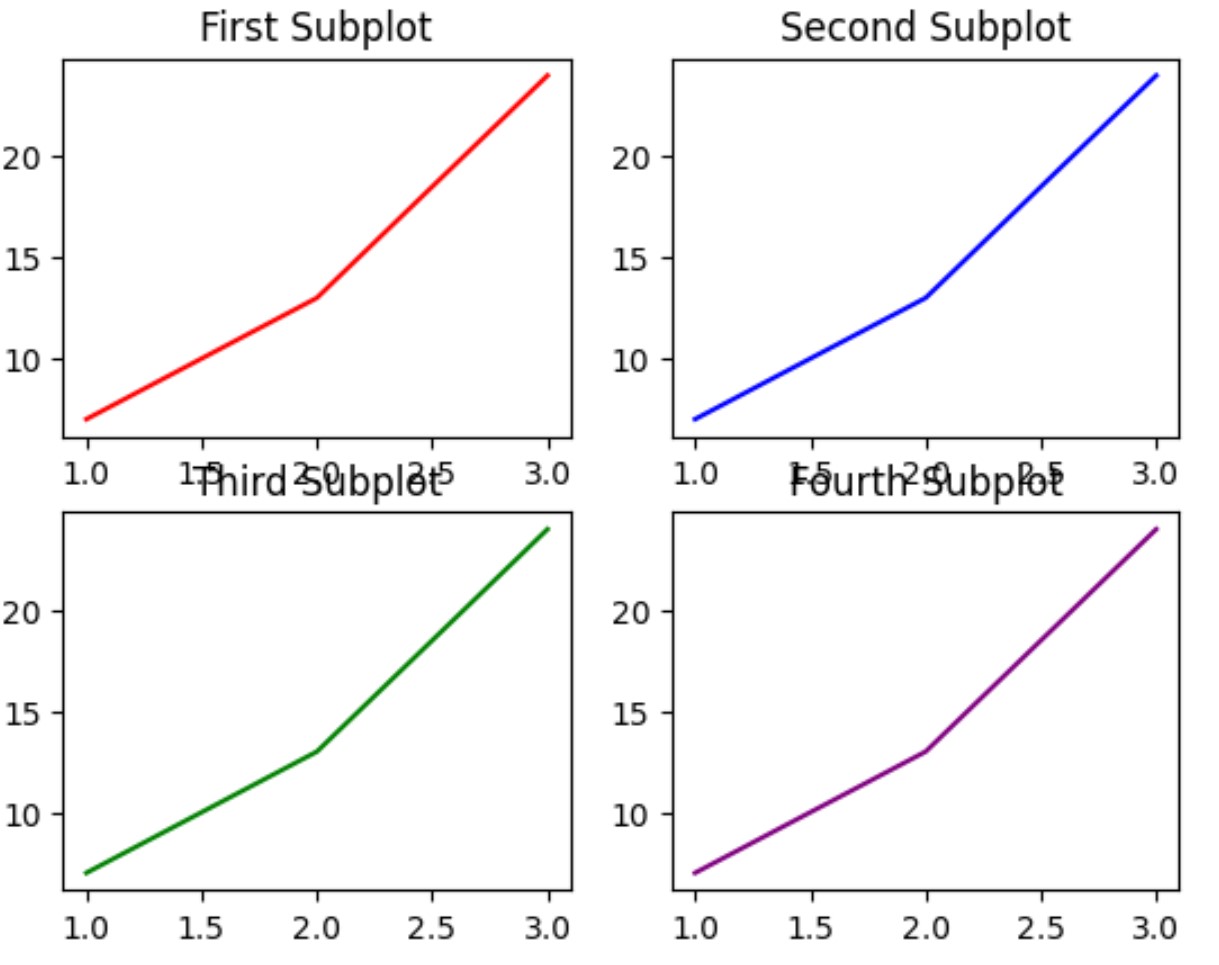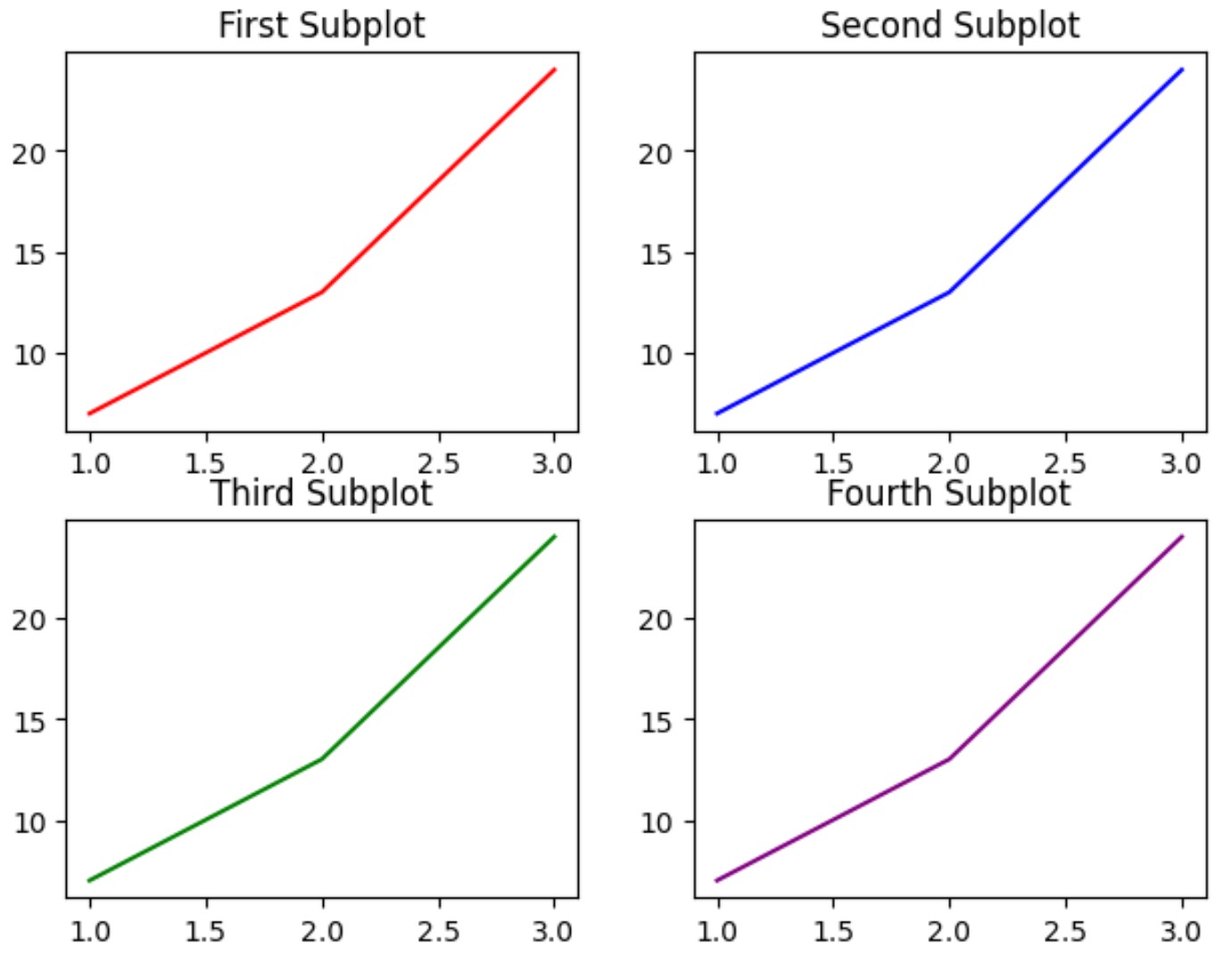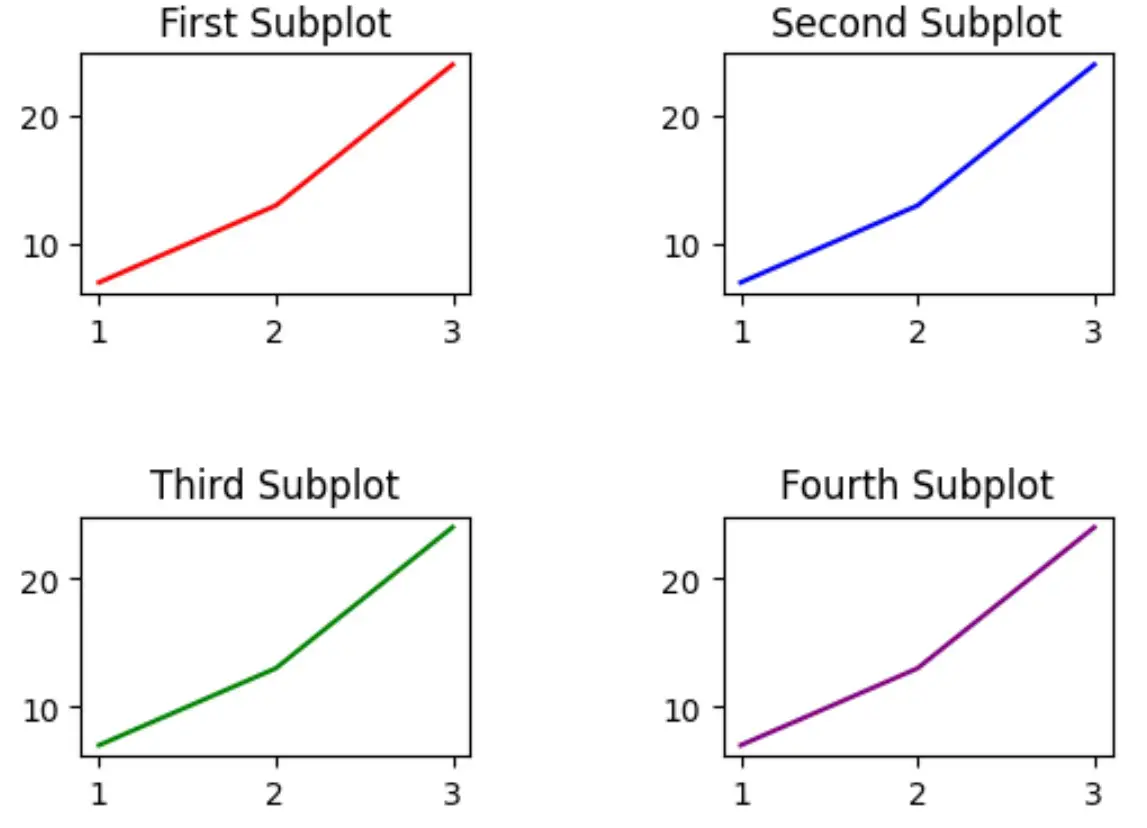Matplotlib တွင် tight_layout() ကိုအသုံးပြုနည်း
သင်သည် Matplotlib တွင် Tight_layout() လုပ်ဆောင်ချက်ကို အသုံးပြု၍ အပိုင်းခွဲများကြားနှင့် အနီးတစ်ဝိုက်ကြားတွင် ကွက်လပ်များကို အလိုအလျောက်ချိန်ညှိနိုင်သည်။
အောက်ဖော်ပြပါ ဥပမာသည် ဤလုပ်ဆောင်ချက်ကို လက်တွေ့အသုံးချနည်းကို ပြသထားသည်။
ဥပမာ- Matplotlib တွင် Tight_layout() ကိုအသုံးပြုနည်း
2×2 ဇယားကွက်လေးခုဖန်တီးရန် Matplotilb ကိုအသုံးပြုသည်ဆိုပါစို့။
import matplotlib. pyplot as plt #define data x = [1, 2, 3] y = [7, 13, 24] #define layout for subplots fig, ax = plt. subplots (2, 2) #define subplot titles ax[0, 0]. plot (x,y,color=' red ') ax[0, 1]. plot (x,y,color=' blue ') ax[1, 0]. plot (x,y,color=' green ') ax[1, 1]. plot (x,y,color=' purple ') #add title to each subplot ax[0, 0]. set_title (' First Subplot ') ax[0, 1]. set_title (' Second Subplot ') ax[1, 0]. set_title (' Third Subplot ') ax[1, 1]. set_title (' Fourth Subplot ')

အချို့နေရာများတွင် ခေါင်းစဉ်များ ထပ်နေခြင်းကြောင့် အပိုင်းခွဲများကြားတွင် ကွက်လပ်အနည်းငယ်သာ ရှိသည်ကို သတိပြုပါ။
fig.tight_layout() ကို သတ်မှတ်ခြင်းဖြင့် ကျွန်ုပ်တို့သည် အပိုင်းခွဲများကြားနှင့် အနီးတစ်ဝိုက်ရှိ padding ကို အလိုအလျောက်ချိန်ညှိနိုင်သည်-
import matplotlib. pyplot as plt #define data x = [1, 2, 3] y = [7, 13, 24] #define layout for subplots fig, ax = plt. subplots (2, 2) #specify a tight layout fig. tight_layout () #define subplot titles ax[0, 0]. plot (x,y,color=' red ') ax[0, 1]. plot (x,y,color=' blue ') ax[1, 0]. plot (x,y,color=' green ') ax[1, 1]. plot (x,y,color=' purple ') #add title to each subplot ax[0, 0]. set_title (' First Subplot ') ax[0, 1]. set_title (' Second Subplot ') ax[1, 0]. set_title (' Third Subplot ') ax[1, 1]. set_title (' Fourth Subplot ')

ကွက်လပ်များကြားနှင့် အနီးတစ်ဝိုက်တွင် ကွက်လပ်များကို ချိန်ညှိထားပြီး မည်သည့်ဧရိယာတွင်မဆို ထပ်နေစေရန်အတွက် မြေကွက်များကို ချိန်ညှိထားသည်။
Tight_layout() လုပ်ဆောင်ချက်သည် ဖောင့်အရွယ်အစား၏ အပိုင်းတစ်ပိုင်းအဖြစ် ပုံအစွန်းနှင့် subpath အစွန်းများကြား padding ကို သတ်မှတ်ရန် pad argument တစ်ခုယူသည်ကို သတိပြုပါ။
မူရင်း pad တန်ဖိုးသည် 1.08 ဖြစ်သည်။ သို့သော်၊ လမ်းကြောင်းများတဝိုက်ရှိ padding ကိုတိုးမြှင့်ရန် ဤတန်ဖိုးကို တိုးမြှင့်နိုင်သည်-
import matplotlib. pyplot as plt #define data x = [1, 2, 3] y = [7, 13, 24] #define layout for subplots fig, ax = plt. subplots (2, 2) #specify a tight layout with increased padding fig. tight_layout (pad=5) #define subplot titles ax[0, 0]. plot (x,y,color=' red ') ax[0, 1]. plot (x,y,color=' blue ') ax[1, 0]. plot (x,y,color=' green ') ax[1, 1]. plot (x,y,color=' purple ') #add title to each subplot ax[0, 0]. set_title (' First Subplot ') ax[0, 1]. set_title (' Second Subplot ') ax[1, 0]. set_title (' Third Subplot ') ax[1, 1]. set_title (' Fourth Subplot ')

မြေကွက်များအနီးတစ်ဝိုက်တွင် ဖြည့်သွင်းမှုများ သိသိသာသာ မြင့်တက်လာသည်ကို သတိပြုပါ။
သင်နှစ်သက်သလောက် လမ်းများပတ်ပတ်လည်တွင် padding ကိုတိုးမြှင့်ရန်အတွက် pad argument ၏တန်ဖိုးကို ချိန်ညှိရန် အားမနာပါ။
ထပ်လောင်းအရင်းအမြစ်များ
အောက်ပါသင်ခန်းစာများသည် Matplotlib ရှိ အခြားဘုံအလုပ်များကို မည်သို့လုပ်ဆောင်ရမည်ကို ရှင်းပြသည်-
Matplotlib တွင် ခေါင်းစဉ်ခွဲများ မည်သို့ထည့်မည်နည်း။
Matplotlib ရှိ subplot အရွယ်အစားကို ချိန်ညှိနည်း
Matplotlib အပိုင်းခွဲများကြား အကွာအဝေးကို ချိန်ညှိနည်း